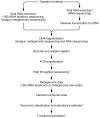Next-generation sequencing: insights to advance clinical investigations of the microbiome
- PMID: 35362479
- PMCID: PMC8970668
- DOI: 10.1172/JCI154944
Next-generation sequencing: insights to advance clinical investigations of the microbiome
Abstract
Next-generation sequencing (NGS) technology has advanced our understanding of the human microbiome by allowing for the discovery and characterization of unculturable microbes with prediction of their function. Key NGS methods include 16S rRNA gene sequencing, shotgun metagenomic sequencing, and RNA sequencing. The choice of which NGS methodology to pursue for a given purpose is often unclear for clinicians and researchers. In this Review, we describe the fundamentals of NGS, with a focus on 16S rRNA and shotgun metagenomic sequencing. We also discuss pros and cons of each methodology as well as important concepts in data variability, study design, and clinical metadata collection. We further present examples of how NGS studies of the human microbiome have advanced our understanding of human disease pathophysiology across diverse clinical contexts, including the development of diagnostics and therapeutics. Finally, we share insights as to how NGS might further be integrated into and advance microbiome research and clinical care in the coming years.
Conflict of interest statement
Figures


References
Publication types
MeSH terms
Substances
Grants and funding
LinkOut - more resources
Full Text Sources
Miscellaneous

